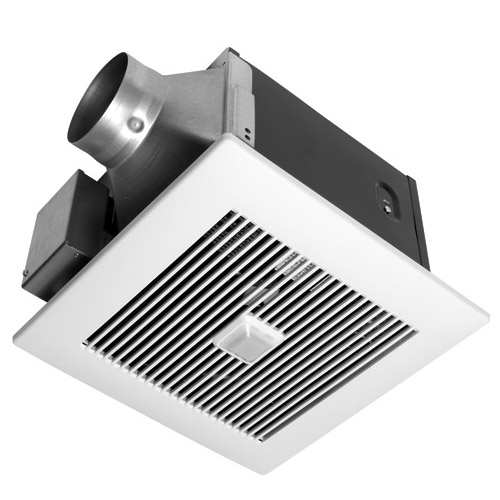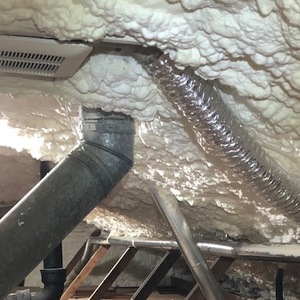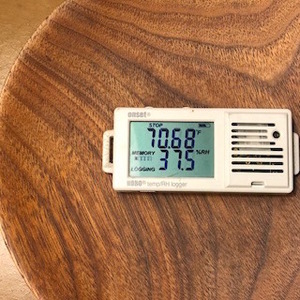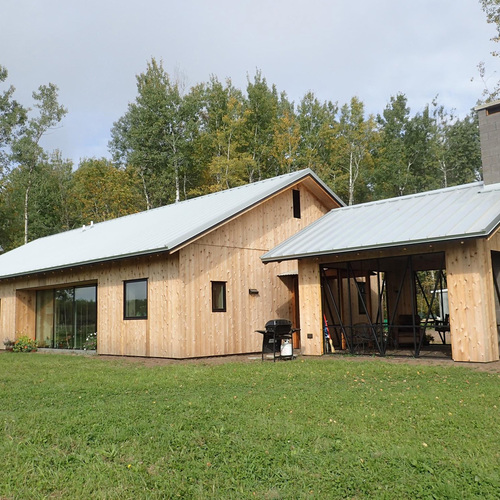Image Credit: Panasonic Corporation
Image Credit: Panasonic Corporation An underground water barrier retrofit allows rainwater to be directed away from the foundation walls; it can make sense in situations where roof gutters aren't practical.
Image Credit: GreenBuildingAdvisor.com
High relative humidity is a significant problem in many regions of the country during the summer months. In hot weather, the higher the humidity, the less comfortable we are–partly because moisture does not evaporate from our skin as readily. More worrisome over the long haul, high humidity levels in the air and high moisture content of materials in our homes can result in mold growth, which, in turn, can cause allergies and other health problems (as well as damage the building itself).
There are two broad strategies for minimizing indoor humidity problems during the summer months: eliminating moisture sources, and removing moisture from the air. This week we’ll take a look at controlling moisture sources; next week we’ll examine moisture removal. Keeping moisture out of a home is almost always less expensive and less energy-intensive than removing that moisture.
Strategies for minimizing unwanted moisture:
Fix drainage problems around the house. If the ground slopes toward the house, moisture will flow toward the foundation during and after a rainstorm, and some of that will seep through foundation walls (or a concrete slab) and into your house.
Install gutters. Capturing rainwater that falls on the roof using gutters, and then directing that water into downspouts and pipes to move it away from the house, rather than letting that water drip off the roof edge, is a great way to minimize moisture entry through the foundation. In a climate with heavy snow, it may be necessary to remove gutters in the winter to prevent damage. To avoid the need for gutters, some people secure a layer of polyethylene to the foundation wall below ground level and slope it away from the foundation–in effect moving the gutter to the bottom of the wall.
Fix leaks. If rainwater is making its way into your house through damaged roofing or inadequate flashing around windows and roof penetrations, get a contractor in to identify and fix those leaks. Not only will that help keep humidity levels down in the house, but it will prevent decay and other problems.
Insulate water pipes. Just as it makes sense to insulate hot-water pipes to save energy, it also makes sense to insulate cold-water pipes to prevent condensation, which can dampen surfaces in the house and contribute to high humidity levels. Foam pipe insulation is readily available and easy to install. Insulate all water pipes that can be accessed relatively easily.
Always use a bathroom fan while showering. If you have one, use it. If you don’t, install one–a high-quality, quiet fan that you and your family are likely to actually use. If you have a bath fan but tend not to use it because it’s too noisy, replace it with a quiet model or discipline yourself to use it anyway, given the benefits. Panasonic led the industry with quiet bath fans in the 1980s, but most major fan manufacturers offer quality models today that produce less than 1.5 sones (a measure of noise). Look for an Energy Star-certified bath fan, which will produce no more than 1.5 sones.
Wipe down the shower after use. Using a squeegee to remove water droplets from the shower after use will direct that water down the drain. Otherwise, that water will evaporate and contribute to the home’s indoor humidity.
Use a kitchen range hood fan. It should be ducted directly to the outdoors; avoid range hood fans that simply filter and recirculate cooking odors, because those fans don’t remove moisture.
Cover pots on your stove. This will minimize evaporation during cooking and will also save energy. In hot humid weather, try to minimize cooking altogether by grilling outdoors or eating more salads.
Put houseplants outside in the summer so that they won’t be introducing moisture into your house. If you have a lot of houseplants, evapotranspiration from them can be a huge source of unwanted moisture.
Don’t dry laundry indoors. If you hang laundry to dry, hang it outside during the summer months. If you use a clothes dryer, make sure that the exhaust hose is property installed and that leaks are not introducing moisture into the house. Periodically clean exhaust hoses to prevent clogging.
Never dry firewood indoors. In rural areas it is not uncommon to bring green firewood directly into the basement for storage. Avoid this practice. As the wood dries it will release huge quantities of moisture into the house–just when you don’t want that moisture.
In addition to this Energy Solutions blog, Alex writes the weekly blog on BuildingGreen.com: “Alex’s Cool Product of the Week,” which profiles an interesting new green building product each week. The most recent such blog is on gas-filled panels that provide up to R-7.6 per inch. You can sign up to receive notices of these blogs by e-mail—on the BuildingGreen.com blog page enter your e-mail address in the upper right corner.
Alex is founder of BuildingGreen, LLC and executive editor of Environmental Building News. To keep up with his latest articles and musings, you can sign up for his Twitter feed.
Weekly Newsletter
Get building science and energy efficiency advice, plus special offers, in your inbox.
















11 Comments
This post will be in all home ownership manuals after today
Great compendium of info Alex for the new home owner.
I applaud your efforts in putting this info together in a readable format.
Permission to pass along.
Why insulate cold water pipes?
I don't agree with the tip that it "makes sense to insulate cold-water pipes to prevent condensation, which can.. ..contribute to high humidity levels." Isn't the moisture that's condensing on the cold pipes already in the house's air? Condensing moist air out on a cold surface doesn't introduce any additional moisture, in fact, if you drained the condensate away, it would help to de-humidify the house air.
Response to Larry
Larry,
You're exactly right; uninsulated cold water pipes don't contribute to high indoor humidity levels.
However, if enough condensation accumulates for the pipes to drip, uninuslated cold water pipes can contribute to problems with mold and rot.
Insulating cold-water pipes
Larry,
I thought about this as I was writing the blog. Here's my reasoning: If warm moist air is blowing through a basement or house--in one window and out another, for example--the relative humidity in the house will rise and fall with the outdoor conditions. If we have condensing surfaces in the house, however, such as uninsulated cold-water pipes, we can retain moisture in the house in water-absorptive materials that the condensation drips. I'm conscious of this, because it's a problem in my own house. As Martin points out, the greater concern is mold and decay, but I think uninsulated pipes can also result in prolonged periods of high indoor humidity by wetting surfaces.
Contrition
A very good point. I was only thinking about my own, sealed-up crawl space, where condensate would drip harmlessly onto plastic poly sheeting. But the continual presence of condensate could also speed up corrosion of my cold water pipes (especially at the joints.)
Good point. Sorry to have doubted you!
Cheap moisture control
I am glad you mentioned drying the shower, Alex. It is simple, requires no electricity and is very inexpensive and effective! Here is what I recommend to folks building, renovating or dealing with moisture issues. Chances are they are going to Ikea anyway. And for $1 it can't be beat!
http://www.ikea.com/us/en/catalog/products/80159524
Ventilation
It is also good to note that many people open windows in the basement space to help dry it out, but this actually introduces moisture when dew point is above the foundation and floor temperature which is typical in many areas in the summer. Also crawlspaces should have a vapor retarder installed on any bare earth, and should not be ventilated.
Clothes Dryer
The dryer itself can be an accomplice in introducing moisture into the home just as leaving that window open in the basement or for that matter leaving the vents open in the summer in a crawl space. A leaky home will go thru multiple air changes and the conditioning system will not be able to keep up with this. (I'm jumping the gun here on your follow-up topic I believe.)
Crawlspace
In southern Illinois, a signifigant source of water vapor for us in the summer is open crawlspace vents. Many still believe that crawlspaces should be vented even when there is a good vapor barrier on the ground. I was in one today that had a good vapor barrier, dry conditions, but condensation on insulated duct work. Vents were open and last night, at 80 degrees, we had 80% relative humidity. I'm a believer that open vents dont dry crawlspaces out, they introduce water vapor.
South East Texas
Good information and relevant to our area. Now is the hottest time of the year for us with temps near 100 and dewpoint near 80...that is a heat index of about 111. You must control humidity in this climate or mold and mildew (along with insects) will flourish.
Good advise.
Bob
In the winter when people are less likely to dry clothes outside on a line, may I suggest a heat pump clothes dryer, which throw off far less humidity into the house than a conventional dryer. Designed as a closed system: wet clothes from the washer are tumbled in warm air, that humid air is moved to separate chamber in the dryer where cooling pipes cause the water vapor to condense and water collect, then pumped off down the drain. The cool dry air is then recirculated back into the warm air chamber to absorb more humidity from wet clothes. Uses less electricity too.
Log in or create an account to post a comment.
Sign up Log in